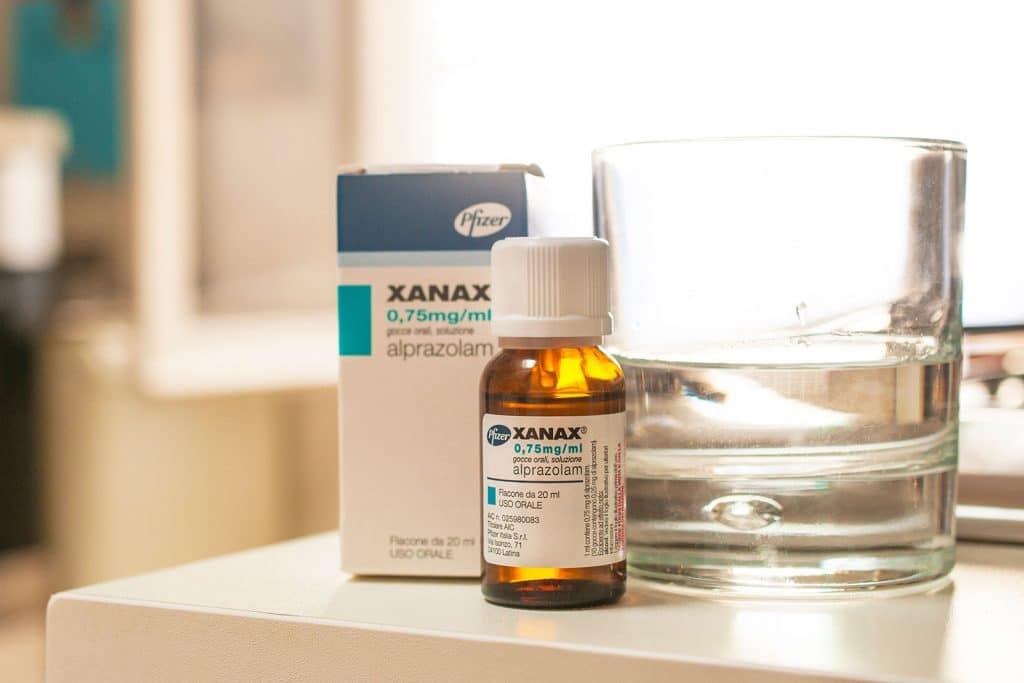Xanax’s generic name is alprazolam. It is an anti-anxiety medication that belongs to a group of substances called benzodiazepines. Xanax is commonly used to treat panic disorders and anxiety. Although it can help improve symptoms, it is an addictive medication. In 2020, more than 4.7 million teens and adults reported misusing prescription benzodiazepines.[1] It is important to understand Xanax and how it affects the brain. Also, it is important to understand the potential risks and effects of long-term use.
Table of Contents
Understanding Xanax
Although some people use Xanax for a long time, experts recommend using it only for a short period.[2] However, it also has off-label uses. For example, it works as a muscle relaxant and a sedative. Benzodiazepines are depressants that are designed to slow the central nervous system. After a person takes Xanax, the substance increases gamma-aminobutyric acid’s effects. As a result, the person feels more relaxed. Since Xanax reduces excitement in the brain, it is an effective treatment for panic disorders and anxiety.

Immediate Effects of Xanax on the Brain
Most people who take Xanax feel the effects within an hour.[3] Its peak concentration in the blood usually occurs within one to two hours. Although the half-life of Xanax is about 11 hours, people feel the effects for varying periods.[3] Metabolism, body composition, dosage, health history and other factors can influence how long people feel the effects. For some people, the effects may last under 10 hours. The effects may last up to 24 hours for others.
When Xanax starts working, it makes a person feel sedated. Its effects on GABA in the brain reduce feelings of stress or anxiety. Also, the effects may cause slowed motor function. Some people report feeling lightheaded. Some people may also experience unpleasant side effects. Memory loss, confusion, hostility, disturbing dreams and irritability are a few examples of potential side effects.[2] Anyone who is prescribed Xanax should understand all the potential side effects before taking the medication.
Long-Term Effects of Xanax on the Brain
Prolonged use of Xanax can cause neurological and cognitive problems. Some people may experience prolonged memory loss.[5] However, some memory loss from Xanax is reversible. Benzodiazepine-induced neurological dysfunction is a proposed term for a condition that scientists are still studying.[6] It encompasses the long-lasting effects of benzodiazepine use. In recent studies, researchers found that a significant number of people suffered prolonged effects after stopping benzodiazepine use. Distractedness, anxiety, nervousness, low energy and memory loss lingered for a year or longer for some participants.[6]
Xanax Tolerance, Dependence and Withdrawal
Xanax’s effects on the brain lead to tolerance over time.[4] That tolerance can be dangerous since it means a person needs more of the substance to feel the same effects. People who build tolerance often become dependent, which means they go through withdrawal without the substance. All these steps can lead to addiction, which requires professional treatment to overcome.
Symptoms of Xanax Withdrawal
It is important to understand the symptoms of withdrawal and watch for them.[7] These are some common symptoms:
- Nausea or vomiting
- Tremors
- Restlessness
- Muscle spasms or pain
- Sweating
- Delirium or confusion
- Headaches
- Insomnia
People who experience withdrawal may also notice a return of their original anxiety or panic disorder symptoms. For instance, someone with a panic disorder may have panic attacks as well.

Xanax and Brain Plasticity
Neuroplasticity is the brain’s ability to adapt to changes and alter responses.[8] Although that ability can be beneficial, it can lead to harmful consequences when the brain adapts to drugs. However, since it also allows people to change their behaviors, it can help reverse drug-related changes. People learn to harness the power of neuroplasticity by developing healthier behaviors and coping mechanisms during addiction treatment. Therapists may recommend family, group and individual therapy.
Managing and Minimizing Xanax Risks
People should only use Xanax when a physician prescribes it. Misusing it by taking someone else’s medication can be harmful beyond the risk of addiction. For example, someone who takes another medication that interacts with Xanax may experience negative or dangerous effects. Also, taking a larger dose or taking the medication more often than prescribed can also be detrimental. People who notice withdrawal symptoms should notify the prescribing physician promptly. Anyone who wants to taper off Xanax should follow their doctor’s specific recommendations.
Xanax Alternatives
Therapists can prescribe other anxiety medications that have fewer risks. Today, there are also many alternative treatments for anxiety. Therapy helps many people improve their quality of life. Diet, exercise and other lifestyle changes may also help. Some people benefit from a career change. The best way to address anxiety is to work with a qualified therapist. Anyone who experiences panic attacks or symptoms of anxiety should seek medical attention. Symptoms can worsen without help and can interfere with many aspects of life.

Xanax Addiction Treatment in Long Island
Although Xanax’s immediate effects may last up to a day, prolonged use or misuse can have long-term negative effects. Do you or someone you know need treatment for Xanax addiction? Whether you obtained Xanax legally or not, Long Island Treatment Center can help. Professional treatment gives you the support you need as you learn to change your habits and behaviors. We offer several levels of outpatient programs for benzodiazepine addiction. Also, we offer dual-diagnosis treatment that focuses on addiction and underlying mental health conditions at the same time. By providing comprehensive treatment, we help people reduce relapse risks. Please contact us to learn more about Xanax addiction treatment in Long Island.
References
[1] https://www.samhsa.gov/data/sites/default/files/reports/rpt35323/NSDUHDetailedTabs2020v25/NSDUHDetailedTabs2020v25/NSDUHDetTabsSect1pe2020.htm[2] https://www.medicalnewstoday.com/articles/326528
[3] https://www.healthline.com/health/how-long-does-xanax-last
[4] https://dailymed.nlm.nih.gov/dailymed/drugInfo.cfm?setid=388e249d-b9b6-44c3-9f8f-880eced0239f
[5] https://www.goodrx.com/conditions/dementia/can-xanax-and-valium-increase-your-risk-of-alzheimers
[6] https://pubmed.ncbi.nlm.nih.gov/37384788/
[7] https://www.healthline.com/health/xanax-withdrawal-symptoms
[8] https://www.health.harvard.edu/blog/brain-plasticity-in-drug-addiction-burden-and-benefit-2020062620479


